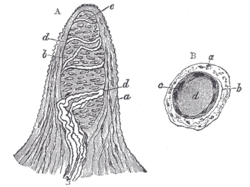- Tactile corpuscle
-
Meissner's corpuscle 
"Sensory nerve endings for touch" labeled at upper right.) 
Papilla of the hand, treated with acetic acid. Magnified 350 times.
A. Side view of a papilla of the hand.
a. Cortical layer.
b. Tactile corpuscle.
c. Small nerve of the papilla, with neurolemma.
d. Its two nervous fibers running with spiral coils around the tactile corpuscle.
e. Apparent termination of one of these fibers.
B. A tactile papilla seen from above so as to show its transverse section.
a. Cortical layer.
b. Nerve fiber.
c. Outer layer of the tactile body, with nuclei.
d. Clear interior substance.Latin corpusculum tactus Gray's subject #233 1061 MeSH Mechanoreceptors Code TH H3.11.06.0.00007 Meissner's corpuscles (or tactile corpuscles) are a type of mechanoreceptor.[1] They are a type of nerve ending in the skin that is responsible for sensitivity to light touch. In particular, they have highest sensitivity (lowest threshold) when sensing vibrations lower than 50 Hertz. They are rapidly adaptive receptors.
Contents
Location
They are distributed on various areas of the skin, but concentrated in areas especially sensitive to light touch, such as the fingers, lips and nipples.[2][3][4][5][6][7] More particularly, they are primarily located just beneath the epidermis within the dermal papillae.[8]
Structure
Meissner's corpuscles are encapsulated unmyelinated nerve endings, which consist of flattened supportive cells arranged as horizontal lamellae surrounded by a connective tissue capsule. The corpuscle is between 30-140 μm in length and 40-60 μm in diameter.
A single nerve fiber meanders between the lamellae and throughout the corpuscle.
The number of Meissner corpuscles per square millimeter of human skin on the fingertips drops fourfold between the ages of 12 and 50. The rate at which they are lost correlates well with the age-related loss in touch sensitivity for small probes (Thornbury and Mistretta, 1981).
Function
Any physical deformation in the corpuscle will cause an action potential in the nerve. Since they are rapidly adapting or phasic, the action potentials generated quickly decrease and eventually cease. (This is the reason one stops "feeling" one's clothes.)
If the stimulus is removed, the corpuscle regains its shape and while doing so (i.e.: while physically reforming) causes another volley of action potentials to be generated.
Because of their superficial location in the dermis, these corpuscles are particularly sensitive to touch and vibrations, but for the same reasons, they are limited in their detection because they can only signal that something is touching the skin.
Comparison with other receptors
Feelings of deep pressure (from a poke, for instance) are generated from Pacinian corpuscles (the only other type of phasic tactile mechanoreceptor), which are located deeper in the dermis, and some free nerve endings.
Also, Meissner's corpuscles do not detect pain; this is signalled exclusively by free nerve endings.
Eponym
Meissner's corpuscles were discovered by the anatomist Georg Meissner (1829–1905).
Additional images
References
- ^ Paré, Michel; Joseph E. Mazurkiewicz, Allan M. Smith, and Frank L. Rice (2001-09-15). "The Meissner Corpuscle Revised: A Multiafferented Mechanoreceptor with Nociceptor Immunochemical Properties". The Journal of Neuroscience 21 (18): 7236–46. PMID 11549734. http://www.jneurosci.org/cgi/content/full/21/18/7236.
- ^ Cauna, Nikolajs; Leonard L. Ross (1960-10-01). "The fine structure of meissner's touch corpuscles of human fingers" (PDF). The Journal of Cell Biology 8 (2): 467–82. doi:10.1083/jcb.8.2.467. PMC 2224947. PMID 13691669. http://www.pubmedcentral.nih.gov/articlerender.fcgi?tool=pmcentrez&artid=2224947. Retrieved 2010-05-07.
- ^ Hoffmann, JN; Montag AG, Dominy NJ. (2004-11). "Meissner corpuscles and somatosensory acuity: the prehensile appendages of primates and elephants." (PDF). Anat Rec a Discov Mol Cell Evol Biol.: 1138–47. http://www.artsci.wustl.edu/~hpontzer/Courses/Hoffman%20et%20al%202004%20Anat%20Rec%20Meissners%20Corpuscles.pdf. Retrieved 2010-05-07.
- ^ Bongiorno, Rita Bongiorno; Spyridoula Doukaki, Mario Aricò (2010-01-25). "Neurofibromatosis of the nipple-areolar area: a case series". Journal of Medical Case Reports 4 (22): 22. doi:10.1186/1752-1947-4-22. PMC 2823760. PMID 20205809. http://www.pubmedcentral.nih.gov/articlerender.fcgi?tool=pmcentrez&artid=2823760. Retrieved 2010-05-07.
- ^ Martini / Bartholomew (1995/2010). Essentials of Anatomy and Physiology 3E. Pearson Benjamin Cummings. http://www.templejc.edu/dept/Biology/RHicks/biol2404Int/biol2404onl_ch5.htm.
- ^ Afifi, Adel K.; Ronald Arly Bergman (1998/2005). Functional neuroanatomy: text and atlas. McGraw-Hill Professional. pp. 16. doi:10.1036/0071408126. ISBN 0070015899. 10.1036/0071408126. http://books.google.com/?id=_cWKT9-P9LAC&printsec=frontcover#v=onepage&q&f=false.
- ^ "Nervous system - Touch". BBC. http://www.bbc.co.uk/science/humanbody/body/factfiles/touch/touch.shtml. Retrieved 2010-05-07.
- ^ Winkelmann, R. K. (1959-01-21). "The Erogenous Zones: Their Nerve Supply and Significance". Proceedings of the Staff Meetings of the Mayo Clinic 34 (2): 39–47. PMID 13645790. http://www.cirp.org/library/anatomy/winkelmann/.
External links
- Donald L. Rubbelke D.A. Tissues of the Human Body: An Introduction. McGraw-Hill. 1999 Meissner's and Pacinian corpuscles
- Dawn A. Tamarkin, Ph.D. Anatomy and Physiology Unit 15 Vision and Somatic Senses: Touch and Pressure
- Gilman S (2002). "Joint position sense and vibration sense: anatomical organisation and assessment". Journal of Neurology Neurosurgery and Psychiatry 73 (5): 473–477. doi:10.1136/jnnp.73.5.473. http://jnnp.bmjjournals.com/cgi/content/full/73/5/473.
- Histology at BU 08105loa - "Integument pigmented skin, Meissner's corpuscles "
- Anatomy Atlases - Microscopic Anatomy, plate 06.123 - "Meissner's Tactile Corpuscle"
- Histology at rutgers.eud
- tactile+corpuscle at eMedicine Dictionary
Nervous system, receptors: somatosensory system (GA 10.1059) Medial lemniscus Touch/mechanoreceptors: Lamellar/Pacinian corpuscles – vibration • Tactile/Meissner's corpuscles – light touch • Merkel's discs – pressure • Bulbous/Ruffini endings - stretch • Free nerve endings – pain • Hair cells • Baroreceptor
Proprioception: Golgi organ – tension/length • Muscle spindle – velocity of change (Intrafusal muscle fiber • Nuclear chain fiber • Nuclear bag fiber)
Spinothalamic tract Categories:- Sensory receptors
Wikimedia Foundation. 2010.


